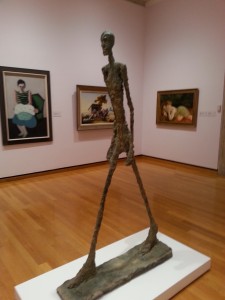Last week I visited CHESS: Cornell High Energy Synchrotron Source. A woman who works there named Laura and GRF David gave us a tour of the operation. The synchrotron is basically a half mile long oval track that carries particles. I was fascinated to learn how the synchrotron works. The aim is to accelerate subatomic particles: specifically electrons and positrons, which are basically positive, antimatter versions of electrons. The synchrotron does this by sending the particles through a large potential difference (voltage drop) to accelerate them up to nearly the speed of light in a fraction of a second. The particles start by whizzing around the synchrotron’s inner ring, and are then transferred into the outer storage ring, CESR. The particles are kept up to speed by going through further potential differences around the track. Their path is curved by magnets to stay in the track, and every few meters they are focused by other magnetic apparatuses.
The synchrotron was initially used to study collisions between matter electrons and antimatter positrons, by accelerating them in opposite directions around the track and then colliding them in a special chamber, where the emitted radiation and particles could be quantitatively and qualitatively measured. This chamber is now being dismantled, as the physicists have determined everything they can about the collisions. Presently, the accelerated particles are being used to produce X-rays which are useful in experiments. Shooting specimens with these X-rays and looking at the resulting diffraction pattern is a way to determine the mechanical properties of the specimens on an atomic scale. I was fascinated by the differing applications. Everyone was there: from the air force testing metal alloys for planes to biological researchers looking at the structure of proteins. I’m interested to see what new advances come out of CHESS in the future!



